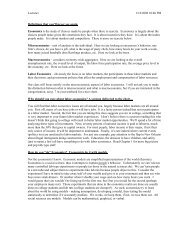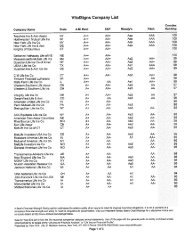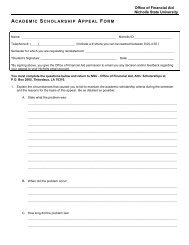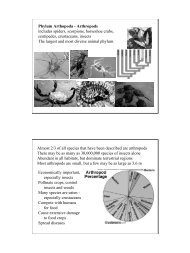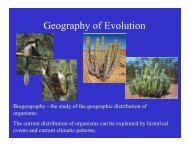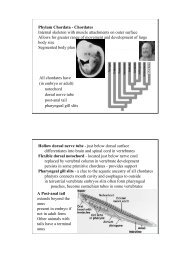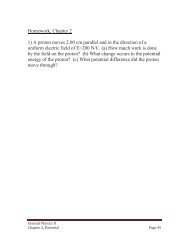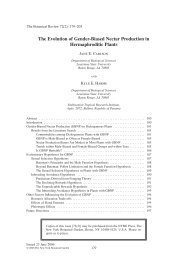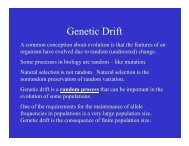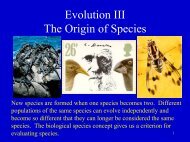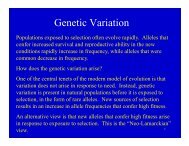Plant Diversity.pdf
Plant Diversity.pdf
Plant Diversity.pdf
Create successful ePaper yourself
Turn your PDF publications into a flip-book with our unique Google optimized e-Paper software.
Kingdom <strong>Plant</strong>ae<br />
Characteristics<br />
chloroplasts with chlorophyll a & b, and carotenoids<br />
cellulose cell walls<br />
formation of cell plate during cell division<br />
starch used for carbohydrate storage<br />
Life cycle - sporic meiosis or haplodiplonic or alternation<br />
of generations<br />
diploid stage (sporophyte) and haploid stage<br />
(gametophyte) are multicellular<br />
dominant stage varies between groups<br />
primitive plants - gametophyte is dominant<br />
advanced plants - sporophyte is dominant<br />
primitive plants have poorly developed systems for<br />
conducting fluids - nonvascular plants<br />
more advanced plants (vascular plants) have well<br />
developed xylem and phloem for conduction
Twelve phyla of plants<br />
Three nonvascular (without water conducting vessels)<br />
P. Bryophyta - mosses<br />
P. Hepaticophyta - liverworts<br />
P. Anthocerophyta - hornworts<br />
Nine vascular<br />
Four seedless<br />
P. Pterophyta - ferns<br />
P. Psilophyta - whisk ferns<br />
P. Lycophyta - club mosses<br />
P. Arthrophyta - horsetails<br />
Five seeded<br />
P. Coniferophyta - conifers<br />
this group is<br />
P. Cycadophyta - cycads<br />
called the<br />
P. Gnetophyta - gnetophyta<br />
gymnosperms<br />
P. Ginkophyta - ginkgo<br />
P. Anthophyta - flowering plants - angiosperms
Characteristics of nonvascular plants<br />
lack vessels for conducting water and foodstuffs throughout plant<br />
Gametophytes green, nutritionally independent of, and more<br />
conspicuous than sporophyte<br />
Sporophyte attached to gametophyte, partially nutritionally dependent<br />
Homosporous - spores of equal size<br />
Require external water for fertilization, only common in moist places<br />
In total about 24,700 species<br />
Three Phyla -<br />
Bryophyta (mosses),<br />
Hepaticophyta (liverworts),<br />
Antherocerophyta (hornworts)<br />
collectively called the<br />
“bryophytes”
Phylum Bryophyta - mosses<br />
Gametophytes small, spiral or alternate arranged<br />
leaves on central axis<br />
Anchored to substrate by rootlike rhizoids<br />
Consists of several cells that absorb water<br />
Leaves superficially resemble true leaves<br />
green, flattened blade, slightly thickened midrib<br />
one cell thick, lack vascular strands and stomata<br />
Most water used by plant travels up on outside of plant, via<br />
capillary action<br />
Some have specialized food conducting cells<br />
Can withstand long periods of drying<br />
Most abundant plants in Arctic and Antarctic, rare in deserts<br />
Mosses are sensitive to pollutants<br />
Poor competitors in environments favorable to growth of higher<br />
plants
Terms:<br />
Sporophyte - a multicellular diploid organism that produces spores<br />
by meiosis - spores germinate and grow into gametophytes<br />
Gametophyte - a multicellular haploid organism that produces<br />
gametes by mitosis can be either male or female, females produce<br />
eggs, males produce sperms, fusion of gametes produces a zygote<br />
that grow into a multicellular sporophyte<br />
Antheridium - the sperm producing organ of a gametophyte<br />
Archegonium - the egg producing organ of a gametophyte<br />
Homosporous - spores (produced by meiosis) are indistinguishable<br />
in size and may give rise to either male or female gametophytes<br />
Heterosporous - spores differ in size<br />
megaspores produce megagametophytes, which produce eggs<br />
microspores produce microgametophytes, which produce sperms<br />
fusion of an egg and sperm produces a zygote that can grow into a<br />
multicellular sporophyte
Other “bryophytes”<br />
Phylum Hepaticophyta -<br />
Liverworts<br />
similar reproduction<br />
to mosses<br />
Phylum Anthocerotophyta<br />
Hornworts<br />
among earliest land plants<br />
Sporophyte has stomata, is<br />
photosynthetic, and provides<br />
much of plant’s energy.
Vascular <strong>Plant</strong>s - have vessels (tubes composed of elongated or<br />
cylindrical cells) for conducting water and food<br />
xylem - conducts water from roots to leaves<br />
phloem - conducts carbohydrates in solution from areas of<br />
photosynthesis (leaves) to support nonphotosynthetic<br />
areas roots, growing shoots, etc.<br />
have a waxy cuticle over leaves to prevent water loss<br />
have stomata (pores) in leaves for gas exchange<br />
all have greater importance and increased size of sporophyte in<br />
life cycle than seen in bryophytes<br />
Vascular plants divided into seedless and seeded<br />
seed - resistant structures suited to protect an embryo from<br />
drought.
Seedless Vascular <strong>Plant</strong>s -<br />
increased importance of sporophyte in life cycle<br />
large sporophyte nutritionally independent of small gametophyte<br />
most are homosporous, spores produce gametophytes that<br />
produce sperm in antheridia and eggs in archegonia<br />
swimming sperm, require water for fertilization<br />
Four Phyla<br />
Pterophyta (ferns)<br />
11,000 spp.<br />
Psilophyta (whisk ferns)<br />
6 spp.<br />
Lycophyta (club mosses)<br />
1150 spp.<br />
Arthrophyta (horsetails)<br />
15 spp.
Phylum Pterophyta - the ferns, whiskferns, horsetails<br />
Ferns: both sporophyte and gametophyte are photosynthetic<br />
sporophyte is large with leaves (fronds)<br />
gametophyte (prothallus) is small, one cell thick, heart-shaped<br />
sporophyte has well developed roots, stems, and leaves<br />
stems are underground - called rhizomes<br />
leaves develop from rhizomes - “fiddleheads” - coiled leaves<br />
leaves can possess spore producing sporangia<br />
sporangia are commonly found in clusters (sori)<br />
a cap (indusium) commonly covers immature sorus
Fern reproduction:<br />
sporangia produce spores, germinate to produce prothalli,<br />
prothalli produces eggs in archegonia, sperms in antheridia<br />
sperm swim to eggs for fertilization,<br />
sporophyte grows from archegonium as gametophyte dies
Whisk Ferns<br />
remnants of earliest vascular plants<br />
sporophyte consists of branching green stems<br />
lack roots or leaves<br />
Gametophytes found in soil beneath sporophytes<br />
Colorless, filamentous form<br />
Have saprobic or parasitic associations with fungi to obtain<br />
nutrients
Horsetails<br />
Commonly called scouring rushes<br />
A single genus, Equisetum<br />
worldwide, mostly in damp places<br />
Sporophytes are ribbed, jointed stems<br />
Arise from underground rhizomes<br />
Whorl of scalelike leaves at each stem node<br />
Stems are hollow, contain silica deposits in<br />
epidermal cells<br />
Two groups - branched and unbranched<br />
branched form resembles a horse's tail<br />
Spores have two ribbonlike elaters (wings)<br />
aid in spore dispersal when dry<br />
curl around spore when damp<br />
Gametophytes are small<br />
Numerous flagellated sperm swim to<br />
archegonia
Phylum Lycophyta: Club Mosses<br />
Worldwide, most common in tropics & moist temperate regions<br />
Resemble mosses, clearly different in internal structures<br />
Sporophytes have leafy stems<br />
Lycopodium is typical<br />
Sporangia produced in conelike<br />
clusters on stems or in<br />
upper leaves<br />
Leaves (microphylls) are short,<br />
linear and in whorls or<br />
spirals<br />
Lycopodium gametophytes are<br />
tiny and carrot-shaped<br />
some club mosses are used as ornaments (e.g. resurrection<br />
plant) many are now endangered species
Seed <strong>Plant</strong>s<br />
first appear in fossil record in rocks dating to about 425 million<br />
years old -<br />
Seeds: have protective seed coat, protects embryo from drying<br />
out, from predators, provides for food storage for embryonic<br />
plant, many have adaptations for dispersal<br />
All heterosporous, gametophyte dependent upon sporophyte<br />
Microgametophytes are called pollen and contain sperm<br />
Megagametophytes are multicellular, contain an egg, and are<br />
found within an ovule on the sporophyte<br />
Pollination precedes fertilization and fertilization may be delayed<br />
Divided into two informal groups<br />
gymnosperms (naked seeds) - ovule not enclosed in<br />
sporophyte tissue when first formed (ovule is naked)<br />
angiosperms (covered seeds) - ovule enclosed in sporophyte<br />
tissue when first formed (ovule is enclosed)
Gymnosperms comprise 4 phyla<br />
Coniferophyta (conifers) - 601 spp.<br />
Cycadophyta (cycads) - 206 spp.<br />
Gnetophyta (gnetophytes) - 65 spp.<br />
Ginkophyta (ginkgo) - 1 sp.<br />
Ovule rests on exposed scale - “naked”<br />
Seed may be covered with<br />
sporophyte tissue at maturity<br />
Sperm may be flagellated but is<br />
delivered within pollen grain
Phylum Coniferophyta - the conifers<br />
Includes pine, spruce, fir, hemlock and cypress<br />
Redwood is tallest plant, bristlecone pine is oldest<br />
Found in cooler, temperate, drier regions of world<br />
Great economic value, timber, paper, resins, turpentine<br />
One hundred species native to northern hemisphere<br />
Most have needle-like leaves, in<br />
clusters of two to five needles -<br />
tough needles retard loss of water<br />
have resins that deter insect and fungal<br />
attack<br />
Wood consists primarily of tracheids<br />
Lack vessels or fibers<br />
absence of fibers causes wood to be<br />
"soft"<br />
Thick bark is an adaptation to survive<br />
fires and subzero temperatures
Conifer reproduction:<br />
heterosporous<br />
Pollen grains produced in male cones,<br />
cluster at tips of lower branches<br />
Male cones composed of small, papery<br />
scales arranged in spiral or whorl<br />
Pair of microsporangia form within<br />
each scale<br />
Microspore mother cells undergo<br />
meiosis, form four microspores<br />
Microspores develop into 4-celled<br />
pollen grains with pair of air sacs
Conifer reproduction:<br />
Female cones produced on upper branches<br />
Larger than male cones, scales become woody<br />
at maturity<br />
Two ovules develop toward base of each scale<br />
Ovule contains megasporangium embedded in<br />
nutritive nucellus<br />
Nucellus completely surrounded by thick<br />
integument, opening called micropyle<br />
One integument layer becomes seed coat<br />
Single megaspore mother cells undergoes<br />
meiosis, forms row of four megaspores<br />
Three break down, one develops into<br />
female gametophyte<br />
Each gametophyte produces two to six<br />
archegonia, each contains an egg
Conifer reproduction:<br />
Female cones may take two or more years to<br />
mature<br />
During first spring are green, with scales<br />
spread apart<br />
Pollen grains carried by wind, catch on fluid<br />
oozing out of micropyle<br />
Pollen grains drawn through micropyle to top<br />
of nucellus<br />
Scales then close<br />
Archegonia and other female parts not mature<br />
for another year<br />
Pollen tube emerges from pollen grain at<br />
bottom of micropyle<br />
Digests through nucellus into archegonia
Conifer reproduction:<br />
Pollen's generative cell divides by mitosis,<br />
one cell divides again<br />
Last two cells function as sperm<br />
Mature male gametophyte is germinated<br />
pollen grain = pollen tube + two sperm<br />
In 15 months pollen tube reaches an archegonium<br />
Discharges contents into it<br />
One sperm unites with egg forming zygote<br />
Other sperm and other cells degenerate<br />
Zygote develops into embryo within a seed<br />
Seed disperses, germinates, grows into new<br />
sporophyte tree
Phylum Cycadophyta: Cycads<br />
Slow growing, found in tropics and subtropics<br />
Cycads resemble pines, ferns and palms<br />
Reproduction<br />
Produce cones, have life cycle similar to pines<br />
Female cones develop upright among leaf bases<br />
Sperm have thousands of spirally arranged flagella<br />
Sperm conveyed to archegonium by pollen tube<br />
Several species facing extinction<br />
Sago palm is used in landscaping
Phylum Gnetophyta: Gnetophytes<br />
Closest living relative of angiosperms<br />
They sre the only gymnosperms with vessels in<br />
their xylem<br />
Gnetophytes differ greatly from one another<br />
Welwitschia stem shaped like large, shallow cup<br />
Tapers into tap root<br />
Two strap-shaped, leathery leaves that grow<br />
continuously<br />
Reproductive structures are cone-like, appear<br />
at bases of leaves<br />
Produced on separate male and female plants<br />
Ephedra comprises more than 35 species<br />
Common in arid regions of U.S and Mexico<br />
Shrubby plants with jointed stems, scalelike<br />
leaves at each node<br />
Natural source for drug ephedrine
Phylum Ginkgophyta: Ginkgo<br />
Fossils show species once widely distributed<br />
Only one species remains: Ginkgo biloba<br />
Historically found in Japan and China<br />
Commonly used in landscaping but no longer<br />
exists in wild<br />
Fan-shaped leaves resemble leaflets of fern<br />
Reproductive features<br />
Sperm have flagella<br />
Reproductive structures produced on<br />
separate trees<br />
Fruits have foul odor<br />
Male plants generally planted, propagated<br />
from shoots<br />
Very resistant to air pollution, often planted<br />
in cities
Angiosperms - one phylum<br />
Phylum Anthophyta - flowering plants - 250,000 spp.<br />
Flowers, heterosporous, double fertilization<br />
ovule and seeds enclosed in sporophytic tissue - carpel<br />
at maturity carpels form fruit around seed<br />
Great variety:<br />
huge trees, tiny duckweed,<br />
microscopic seeds to<br />
coconuts<br />
mostly photosynthetic<br />
autotrophs, some parasitic
Flower structure:<br />
modified stems bearing modified leaves<br />
base is pedicel, with receptacle, to which all other parts attach<br />
four whorls of modified leaves: calyx composed of sepals,<br />
corolla composed of petals,<br />
androecium composed of stamens,<br />
gynoecium composed of carpels or pistils<br />
Ovary completely<br />
encloses ovule<br />
Stigma is to accept<br />
pollen<br />
Anther produces<br />
pollen<br />
Many flowers<br />
produce nectar
Angiosperm life cycle<br />
Megaspore mother cell produces four cells via meiosis<br />
Three disintegrate, one survives, divides mitotically<br />
Each daughter nucleus divides twice resulting in eight haploid<br />
nuclei - arranged in two groups of four<br />
One nucleus from each group migrates to center - polar nuclei<br />
Cell membranes and walls form around remaining nuclei<br />
Cell closest to micropyle functions as egg - others called synergids<br />
Integument layers become<br />
seed coat - with small<br />
opening - micropyle<br />
The mature female<br />
gametophyte is called an<br />
embryo sac - with eight<br />
nuclei in seven cells
Angiosperm life cycle<br />
Male gametophyte develops in the anthers<br />
Anthers have four patches of tissue<br />
Each patch composed of many diploid microspore mother cells<br />
Undergo meiosis to produce four microspores each<br />
Nucleus of each divides once by mitosis<br />
Two layered wall develops around each microspore<br />
Binucleate microspores are now pollen grains<br />
Outer layer called exine, sculpted, contains chemicals<br />
May also have apertures through which pollen tube may emerge
Pollination:<br />
The movement of pollen from the<br />
anther to the stigma<br />
Pollen grain contains two nuclei:<br />
tube nucleus<br />
generative nucleus<br />
Tube nucleus begins formation of<br />
pollen tube - extends into style<br />
Generative nucleus follows and<br />
divides to form two sperm<br />
nuclei - pollen now considered<br />
mature gametophyte<br />
Tube nucleus enters embryo sac<br />
at micropyle<br />
Sperm nuclei follow
Double fertilization:<br />
One sperm nucleus fuses with egg to form zygote<br />
The other sperm nucleus fuses with both polar nuclei to form<br />
triploid (3N) endosperm nucleus<br />
Endosperm multiplies to serve as nutrition for developing embryo<br />
Seed consists of:<br />
diploid embryo - derived from a sperm and egg<br />
triploid endosperm - derived from a sperm and two polar nuclei<br />
diploid seed coat - derived from sporophyte parent<br />
Fruit develops from ovary - is derived from sporophyte parent
Angiosperm success:<br />
First appeared about 200 million years ago (Jurassic) and became<br />
dominant plant group by the end of the Cretaceous (70 million yeas<br />
ago).<br />
First pollinating insects appeared about 50 million years ago.<br />
Flowers attract pollinators and allow more efficient dispersal of<br />
pollen<br />
Fruits protect seeds and aid in seed dispersal<br />
Endosperm provides additional nutrition for developing embryo
Classes of Angiosperms:<br />
Class Monocotyledonae - “monocots” - 65,000 spp. - lilies, grasses,<br />
palms, agaves, yuccas, orchids, irises, bananas<br />
Class Dicotyledonae - “dicots” - 175,000 spp. - most familiar<br />
flowering plants - most trees and shrubs, most familiar flowers and<br />
garden plants<br />
Monocots:<br />
one cotyledon - “seed leaf”<br />
parallel venation in leaves<br />
lateral meristems rare - no lateral<br />
growth<br />
flower parts in multiples of 3<br />
few annual species<br />
many with bulbs or underground<br />
storage organs<br />
no true wood (secondary xylem)<br />
Dicots:<br />
two cotyledons<br />
netted venation in leaves<br />
lateral meristems common<br />
flower parts in multiples of 4 or 5<br />
many annual species<br />
few underground storage organs<br />
true wood in many species




